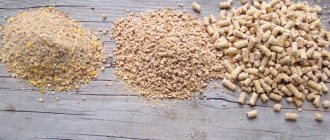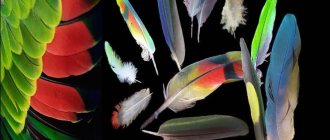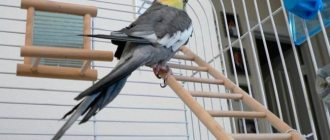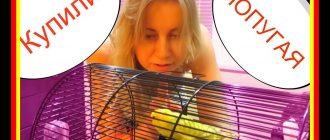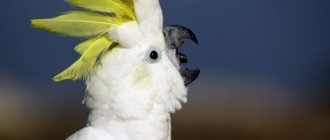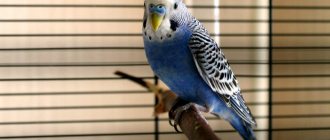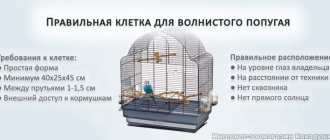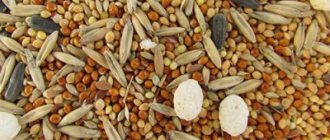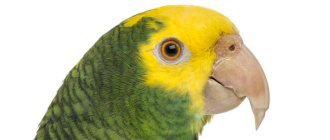Cockatiels are Australian crested parrots with developed intelligence and a peaceful disposition. Thanks to their memorable appearance and conversational abilities, the birds became popular far beyond their natural range, but did not change their eating habits. We will learn how to properly organize feeding a cockatiel and what foods should not be given to a parrot.
Daily norm
Rule one: food from the owner's diet is not intended for the bird. You need to purchase or prepare balanced food for your parrot from several types of cereals, nuts, and grains. The bird should consume 40 g of cereal mixture per day. We divide the daily norm by the number of feedings and get 10–15 g per meal. This is approximately 1 tablespoon. The cockatiel constantly eats something in the cage, so it should be limited.
To determine the diet of a domestic bird, you need to find out what cockatiels eat in their natural habitat. Their homeland is Australia, and their main food is the seeds of steppe plants. What do Corella parrots like to eat in their homeland? These are mainly cereals, nuts and greens. In addition to natural food of plant origin, parrots catch insects - this is a source of natural protein.
How to switch a cockatiel to pelleted food?
This is not always easy to do. Initially, parrots may not even consider the pellets to be food. It will take about 4 - 8 weeks to wean off the seeds. To do this, constantly give your parrots granules in a separate saucer. Some people mix the granules with a small amount of seeds. But you must be aware that your bird will not accidentally eat the pelleted food. The transition to a different diet may take several days, weeks or months.
- Never remove all seeds without making sure your bird is eating the pellets as well as fruits and vegetables. Birds are stubborn, but they can be trained. There's no doubt that this can be a very stressful time for you and your budgie.
- Consult your veterinarian if any transition or health concerns arise. An experienced doctor will correctly advise you on what you can give your cockatiel parrot to eat.
- Remember that you are training a bird, don't let it lead you .
Basic diet
You can buy store-bought balanced food for parrots. The basis of poultry nutrition is food made from a mixture of cereals. It includes millet, oats, wheat. It is not advisable to purchase mixtures that contain sunflower seeds for daily use. This cereal is too fatty for birds. Birds can eat them no more than once every 7 days. It is not advisable to consume only dry food; other additives are also needed. It is important to choose a balanced food for your pet cockatiel and find out which one is best.
The diet of a cockatiel can be divided into main and additional.
The main foods include cereals:
- wheat;
- millet;
- oats.
The daily diet also includes seeds:
- flax,
- wild flowers,
- sesame,
- hemp,
- sunflower,
- pumpkins.
Several types of nuts: walnuts, hazelnuts, peanuts.
The composition of the mixture is distributed as follows: 30 g of oats and millet, 10 g of canary and sunflower seeds, 5 g of corn and wheat, 1 g of hemp and flaxseed, 3 g of weed seeds. It is important to feed the cockatiel parrot the way it eats in nature.
If the food is prepared independently, the grains must be crushed. This improves the bird's digestion of food. It is preferable to use whole grains in softened form in food for birds, including cockatiels.
What about people eating?
If you and your family eat healthy and nutritious food, your bird can eat it too. When doing so, follow the general recommendations discussed above and use common sense. Some parrots even enjoy a little lean cooked meat, fish, eggs or cheese on occasion. This is what cockatiels sometimes eat. Dairy products should be consumed in moderation. Common sense - avoid :
- unhealthy, sweet or salty foods,
- chocolate,
- products containing caffeine,
- alcoholic drinks.
Cereals
Millet is good for small pet parrots. Cockatiels choose red millet because it has more nutrients. It will be lucky if you can find panicles of milk-ripe millet. This is a good way to feed the chick.
Oats are the most suitable food for cockatiels. Parrot chicks are fed with young oats of milk maturity, steaming it with boiling water. However, you should not cook the cereal. Adults are given whole grain oats. The feathered one can easily cope with cleaning it from the husk. Sprouted oats are good to include in the diet of individuals during the mating season: vitamin E in its composition stimulates reproductive function.
Canary seed . It is the most suitable and nutritious grain and food for parrots. The proportion of protein in it is up to 20%. Suitable for all types of parrots. Commercial feed contains 30% canary seed. Birds in the disease or molting stage are given half the daily ration. The ratio of nutrients in canary seed and oats is almost the same. These cereals are considered interchangeable; it is impossible to determine which is better.
Corn is the main supplier of coarse fiber and carbohydrates; it contains proteins. The composition does not contain the necessary amino acids, so it is not worth feeding the bird with corn alone. Start complementary feeding with milk cobs.
Hemp is the favorite food of most birds. Corella also eats these grains well. The seed contains up to 30% very fatty oil; it is used for cockatiels at home in the spring and during nesting. The daily norm is 5% of the total volume. Boil for 10 minutes and add to food.
Flaxseed is added to food as a medicinal supplement. It has a laxative effect for cockatiels, so do not consume more than 2% of the daily requirement. Few people know what can be given for stomach diseases in birds. Flax seed in the form of a mild decoction will help. It protects the digestive tract from the effects of whole grain feed. For coughing and hoarseness, use a decoction of flaxseed, adding it to the drinking bowl.
Attention! Exceeding the norm of flaxseed, hemp and sunflower seeds in the daily diet is fraught with metabolic disorders.
Wheat is a valuable grain in bird nutrition. It is not advisable to use unprocessed grain. To feed your home cockatiel, use grain soaked in water or sprouted. This vitamin supplement is necessary during the difficult nesting period, in winter and during feeding of offspring. Sprouted wheat is rich in vitamin E - a valuable additive to feed for poultry and parrots.
Nuts are the cockatiel's favorite food. This delicacy for parrots makes up only 5% of the total food, because the presence of a large amount of fatty oils in the composition can harm the bird.
Important! Exceeding the norm of a variety of nuts in the diet of a home cockatiel can lead to metabolic disorders.
Large nuts must be cracked, and small ones must be completely shelled. A parrot can easily remove a half-cracked shell.
Prebiotics in your cockatiel's diet
A natural prebiotic for cockatiels is clay. This rock restores the intestinal microflora and supports beneficial bacteria. It is necessary to offer clay to birds with poor plumage in the form of balls, beads, or a cake will do. Kaolin can be purchased at a pharmacy, and at home you can use it as follows:
- dilute with water until creamy;
- add flax or sesame seeds;
- spoon the mixture into scones onto the parchment paper;
- place in the oven until hardened, 15 minutes.
The cooled clay mixture will be an excellent medicinal addition to your parrot's diet. Baked clay cake is the cockatiel's favorite treat.
Communication with a parrot
Corellas are vulnerable and sensitive birds. Especially the females. Therefore, you should adhere to certain rules of communication with them:
- Adaptation. The parrot needs to get used to you and the new place. Usually adaptation takes 1 - 3 days. At this time, it is better not to touch him, talk calmly. You can even sing, so he will get used to you faster.
- Attention. Communicate with the bird as often as possible. Let him out of the cage, sit him on your hand, play. Cockatiels like to be stroked on the head in the direction of their hair growth. At first the parrot may not be able to handle it, but gradually it will become tame and get used to it.
- Accuracy. Corellas are sensitive birds. An awkward movement can lead to injury. Therefore, it is not recommended to have a parrot in a family with children under 3 years of age.
- Aggression. If the bird begins to bite, do not scold it. Understand the reason: insufficient care, uncomfortable conditions, little communication. Cockatiels don't bite for no reason.
Be patient and caring. Especially when learning to speak. Repeat the words one at a time. This way the parrot will learn the word by ear, react to it, and later pronounce it. You shouldn’t give out whole phrases at once. This will cause the bird to become confused and training may take longer.
Supplement to the diet
Parrots need some greens added to their diet. Dandelions, leeks, and celery are suitable as such additives. As a nutritional supplement, you can offer corn, cookies, and a boiled chicken egg. If you have doubts about the quality of greens, you can grow them at home. It's good to germinate wheat. There will definitely be no doubt about its quality. Wheat sprouts contain a lot of vitamin E, which has a beneficial effect on the health of birds.
It is important to know what to feed your cockatiel at home in winter or spring. You can feed with twigs of pine, linden, birch, and also offer lettuce or spinach leaves.
What should you always do when feeding your cockatiel?
- Monitor the amount of food your bird eats.
- Give clean, fresh water every day.
- Feed your cockatiel a variety of fresh foods, fruits, and vegetables daily.
- Wash feeders and drinkers every day, change food and water.
Some foods that can be offered to your cockatiel are: apple, cherry, pear, apricots, peas, asparagus, coconut, banana, corn, pineapple, beans (cooked), cucumber, plum, dandelion, leaves, pomegranate, bud, dates, potatoes, lentils, pumpkin, figs, grapes, raspberries, grapefruit, rice (brown), soy, cabbage, lettuce, beets, kiwi, spinach, blueberries, melon, sprouted seeds, broccoli, mango, pumpkin, Brussels sprouts, nectarines, strawberries, cabbage , orange, melon, papaya, tomato, carrots, peaches.
Vegetables and fruits
The parrot needs the fruits of various plants as food. You can eat all vegetables without restrictions. As fruits, mangoes and persimmons should not be given to cockatiels because of their astringent properties. It is not advisable to introduce large quantities of walnuts into your cockatiel's diet: they are too fatty for the parrot's body. The fruits are cut into small pieces, each is introduced separately from the other and the reaction is checked. This feeding is given in small portions.
Cockatiels love almost all fruits eaten by humans - apples, pears, apricots. They also eat citrus fruits: oranges, tangerines, lemons. Corellas love berries: raspberries, currants, gooseberries.
Among vegetables, cockatiels prefer zucchini, pumpkin, and carrots. To replenish the body with protein, the parrot is given boiled lean meat. Other protein foods for cockatiels: boiled eggs, cottage cheese, milk.
Porridge for cockatiels
Cooking rules:
- Boil in water.
- Without salt and granulated sugar.
- Cook to the state your cockatiel likes, that is, to a crumbly or viscous porridge.
- You can chop fruits and vegetables, then add them to the porridge after cooking.
Types of cereals suitable for cockatiels:
- oats (oatmeal),
- pearl barley,
- buckwheat,
- rice,
- millet.
Nutrition during illness
If your pet is sick, you need to reduce the calorie content of its diet and leave only greens. It is good to feed the bird with herbs with medicinal properties during this period.
If a goiter is diagnosed, it is good to water off the parrot with a decoction of willow bark. You can prepare a decoction of calendula flowers. These plants cope well with thyroid pathologies.
If your parrot has diarrhea, it is important to decide what to feed or water your cockatiel. You can offer him a decoction of chamomile or fennel flowers. These medicinal herbs can be purchased at the pharmacy.
In the spring, if there is a possibility of decreased appetite, St. John's wort or plantain leaves are brewed. What can you give if your pet has a blood supply disorder? Strong black tea will help cope with this problem.
Water mode
A parrot should always have water. Change the water in the sippy cup regularly (at least once a day). Wash the sippy cup thoroughly to remove deposits. If you have an open drinking bowl, make sure the water in it is clean. The disadvantage of this form is that food residues, husks, fluff, feathers and bird droppings constantly get into the water. Such water can poison the parrot, so it will have to be changed more often than once a day.
What can you give cockatiels to drink:
- still bottled water;
- bottled baby water;
- filtered;
- decoction of chamomile or rose hips;
- berry compotes;
- freshly squeezed fruit and vegetable juices.
Appearance
The bird seems larger than budgerigars, its length is 30 cm. But most of it is in the long tail, and the dense plumage gives the bird a respectable appearance. A characteristic feature of this species is a militantly raised crest and a beak curved down, like other cockatoos, but somewhat shorter. Color varies greatly due to the large number of varieties bred in captivity.
Consider the appearance of the Corella parrot, which lives in Australia:
- olive plumage;
- the crest and head are bright yellow;
- pink cheeks";
- gray beak;
- long tail, pointed at the end.
Females have a paler color, they are not so bright and expressive, so it is quite easy to distinguish a male and a female.
Chicks have their mother's color for up to a year, and then it changes depending on the sex. To prevent the bird from flying out of the window, its wings are clipped. Flights around the house are allowed, otherwise Corella will not be comfortable in a confined space. The weight of an adult bird is about 100 g. The Corella parrot is a long-lived parrot that can outlive other pets, for example, a cat. With good care, the life expectancy is 25 years, but this is the maximum age. Usually the bird lives up to 15-18 years.
Note: Breeding such parrots is quite simple, so many subspecies with different plumage colors have been created. Of particular interest were cockatiels, which have white spots on their plumage. They became the basis for the creation of new subspecies.
Prohibited Products
Corella parrots should never be fed salty, sweet, fatty or fried foods. They are also prohibited from giving alcohol.
Here is a list of foods that correlators are prohibited from eating:
- mushrooms;
- avocado;
- mango;
- papaya;
- persimmon;
- bird cherry;
- parsley;
- dill.
Parrots should not eat the pits of apples, cherries, or peaches.
Migratory or wintering
The photo shows a yellow cockatiel on a branch.
Corellas are capable of covering considerable distances, but they are not migratory birds. In winter in Australia, the thermometer does not drop below 0°C, so birds can easily cope with this time of year. In addition, winter is considered the rainy season, when plants receive sufficient moisture and increase their growth, providing food for birds.
Cockatiels were forced into Europe on ships, but not a single bird left Australia on its own.
Fresh herbs
A natural source of fiber and vitamins. You can make bouquets of greenery and place them next to the feeder. The cockatiel will happily gut this bunch.
Take precautions! Be sure to pour boiling water over the product before serving. Beware of ticks and other parasites.
For greens, non-spicy herbs without specific odors are suitable. The ideal option is beet and carrot tops.
What to feed the chicks
In normal condition, parent parrots are able to independently feed their offspring. This is the best thing for the health of growing cockatiels. But, often, females can abandon their chicks. In this case, you need to prepare feed.
To do this, take the ingredients and mix until smooth (something like sour cream). The resulting composition must be heated to a temperature of 37-38 degrees. Feeding frequency: every 2 hours, around the clock. Serving size is no more than a pea at a time.
WHAT IS THE CORRECT FEED TO FEED A PARROT. The diet of my cockatiels. Healthy eating for a parrot.
Mix 1
Required:
- baby formula powder – 1 tbsp. spoon;
- semolina – 2 tbsp. spoons;
- calcium – 3 tablets;
- glucose – 3 tablets;
- boiled egg - 2 pieces.
This is a recipe for newly hatched chicks.

